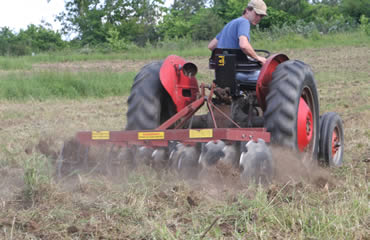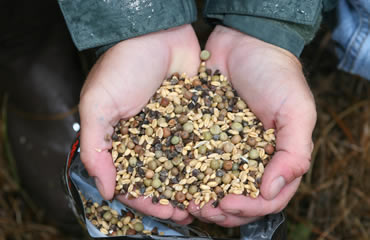Think about your goals to determine what to plant.
When did things get so complicated? It seems like you need a degree in agronomy to grow some deer food these days. Soil sample. Fertilizer. Herbicides. Tractor or ATV? Disk or tiller? Clover, wheat, beans or chicory? It’s enough to make some hunters quit before they even begin.
The good news is that you don’t have to be a plant scientist to grow a healthy, productive food plot. You should always conduct a soil sample, of course, but anyone with a few pieces of equipment and some time can turn a patch of dirt into a deer magnet.
The question is, which plants are the right ones?
That depends mostly on the purpose of your food plots, says Whitetail Institute Vice President Steve Scott.
“There are two main considerations,” he says. “Do you want to plant for nutrition or for attraction? Nutrition plots grow in the summer and give deer lots of protein that helps grow bigger antlers. Attraction plots are typically grown in the fall for hunting, although deer benefit from the nutrition they offer, as well.”
COOL SEASON PLANTS
Perennial Clover: White clover is one of the best all-purpose food plot choices. A well-maintained plot with balanced soil can last five years or more, and deer will visit it as long as it’s green. It’s somewhat less hardy in the Deep South, but it still grows well and can last several years. No matter where it grows, whitetails love it. It’s an excellent choice for serious bowhunters, but whitetails will visit a clover patch during late gun seasons in many regions.
“It’s probably the best all-purpose food plot plant there is,” says Scott. “It’s pretty easy to grow and maintain.”
Quality Deer Management Association biologist Kip Adams agrees. He’s planted a variety of plot plants and says clover is a sure bet almost anywhere it’s used.
“I can’t think of any region or situation where it won’t work,” he adds.
Brassicas: Brassicas are annuals that include a variety of plants like turnips, rape, kale and broccoli. They are typically fall-planted seeds and serve as an excellent late-season attractant. In some regions, deer won’t touch them until the plants have been subjected to a couple of frosts or even a hard freeze. The intense cold converts the plant’s starches into sugar, making them more palatable and far more attractive and nutritious.
With proper soil, adequate moisture and full sun, brassicas have one of the highest forage yields of any plot plant, up to 10 tons per acre. However, Antler King spokesman Todd Stittleberg doesn’t recommend them in the Deep South, where freezes are rare.
“Brassicas need a deep freeze to turn them into something deer will eat, and the South doesn’t always get the necessary cold spells,” he said.
Wheat: Inexpensive and hardy in a variety of climates, wheat is a great all-purpose food plot choice. It grows throughout whitetail country, even in drier climates, and deer absolutely love it. Even better, it’s easy to grow and can produce a lush field of deer candy simply by tossing it on the ground. Of course, like any seed, wheat grows best when it is covered by dirt, and it always requires soil contact when it is top-sowed, but it doesn’t have to be drilled and it doesn’t require a load of fertilizer. Adams says wheat is typically an attractant, meaning it’s a great choice for hunting plots throughout the fall and into winter. Whitetails will eat it in early spring but stop when the stalks reach 6 inches or so in height.
Forage Oats: Oats are similar to wheat, but deer actually like oats better, says Adams.
Evolved Harvest senior account executive B.J. Wolf agrees. However, both men warn that oats purchased from a farm supply store won’t be as favorable to deer as forage oats. “Forage oats last longer in cold weather,” Wolf said. “They have a deeper root system, so they are more drought-tolerant, and they have a higher yield.”
They also provide more nutrition and are more palatable. Oats are easy to grow and will thrive in a variety of soils, too.
Rye: Annual rye grass is often used as a cover crop to stabilize erosion-prone soil on crop fields, new lawns and construction sites. However, generic rye sold at farm supply stores is not favored by deer, at least not when other foods are readily available.
That’s why Wolf recommends using a forage rye designed specifically for deer. “Forage rye will continue to grow after it’s been eaten,” he said. “It has higher sugar and protein content, and it produces a higher yield than generic rye grasses.”
Even better, adds Wolf, rye will grow just about anywhere. “I’ve seen it growing in our parking lot from bags that have been spilled,” he says. “It’s a great choice if you are short on time. It sprouts and establishes itself faster than just about any other seed.”
 WARM SEASON PLANTS
WARM SEASON PLANTS
Corn: Corn doesn’t provide nutrition during the summer, but deer love it, especially in late winter when other food sources are scarce. It requires lots of nitrogen, so it can be expensive to grow. It also it takes up a lot of space. Most management professionals recommend a minimum size field of at least an acre or two, even more in areas with high deer densities. That’s because raccoons, crows and bears love corn, too, and a small patch probably won’t last up to or through hunting season.
While short on nutrition, corn is extremely high in energy. In harsh climates especially, energy is just as important as nutrition, and deer will practically live in corn. Adams recommends leaving all or part of it standing, especially in northern regions that are prone to deep snow.
“There are Round Up-ready varieties that are great for food plots, but I would make sure the variety you buy is suited for your soil and weather,” notes Adams. “Your local farm supply store will likely have varieties that fit those requirements.”
Peas: Cow peas and Austrian winter peas are great summer plot choices that produce high yields throughout the growing season. But, like any food plot plant, they might not last long in areas with high deer densities. Whitetails will hammer a preferred food source as soon as they discover the plants.
That’s okay, of course, but it’s a good idea to plant lots of peas so they last at least into the early fall. Austrian winter peas tend to be more tolerant of colder weather and are a better choice in the north, but Adams says other varieties can do just fine in northern regions.
Peas are part of the legume family and, like beans and clover, peas fix nitrogen, meaning they add the vital nutrient to the soil instead of using it.
Alfalfa: Another favorite high-nutrition deer food, alfalfa is appealing in drier regions where other forage can be tough to grow. The perennial not only serves as a warm-season nutrition source, but also as an autumn attractant. Deer devour it as long as the plant is actively growing.
Alfalfa can be finicky, however. It’s prone to disease and insects, and it needs periodic mowing and baling. Scott says alfalfa left to grow can become unpalatable for deer, and if mowed and left on the ground, it will choke out the plants underneath.
If you have a farmer who will bale it, then I wouldn’t hesitate to give it a try,” adds Adams. “I recommend varieties designed specifically for food plots, because they have more leaf and less stem. Deer don’t like the coarse stems of cattle forage alfalfa.”
Pennington Seed food plot expert John Carpenter agrees and adds that alfalfa is not the best choice for those with little time to spend maintaining a food plot.
Chicory: Another high-quality plant that produces a huge amount of forage in the summer, chicory is a great addition to any food plotter’s landscape. In fact, Carpenter says it’s his favorite alternative to alfalfa. Chicory requires far less maintenance than alfalfa and tends to have a longer growing season while providing a higher yield and an equal amount of protein during the summer.
“Chicory is a nitrogen hog, which is why we offer a chicory/clover blend called Buckmasters Ultimate,” Carpenter said. “Clover fixes nitrogen, while chicory uses it, so the two plants grow very well together.”
Adams typically mixes chicory with his clover because it has a deep root system. That allows chicory to flourish during a hot, dry summer when clover can go dormant. The broad leaves also help shade the clover and the ground, which ultimately preserves valuable moisture.
Chicory is a perennial that can outlast a stand of perennial clover, and it’s relatively easy to grow. The only potential problem, notes Adams, is the difficulty of controlling weeds in a chicory-clover mix. Selective herbicides may be safe for one plant but will likely kill the other.
Beans: Who hasn’t seen a bachelor herd of bucks feeding on the edge of a summer soybean field? Beans are extremely high in protein and contribute to antler growth as well as the overall health of the deer that eat them.
Adams says forage-type beans designed to produce fewer beans and more leaves are the best choice for hunters. They stay green longer and produce a higher amount of forage for deer, which tend to favor the leaves.
Of course, deer will eat the beans themselves, and a bean field can provide excellent hunting opportunities well into the hunting season. Beans also fix nitrogen, so they can be mixed with corn to reduce the amount of fertilizer you have to buy.
 THE BENEFITS OF BLENDS
THE BENEFITS OF BLENDS
Still not sure what to plant? A number of seed companies now sell blends, a mix of different plants that typically grow well together. Some, like Pennington’s Feeding Frenzy and Whitetail Institute’s Pure Attraction, are fall-planted blends that serve as attraction plots. Others, like Pennington’s Buckmasters Ultimate, a blend of three clovers and choice chicory, are warm-season plants that help deer gain weight and grow bigger antlers.
Ferry-Morse marketing director Jason Gibbs says his company’s blends are typically combined to provide foods that start early and last well into the hunting season. “Our Food Plot Mixture has oats, wheat and rye, which germinate quickly, and brassicas and clover, which take a little longer but last into the winter,” he says.
What you use is limited only to your imagination, not your education. Food plots aren’t rocket science. Think about what you want to accomplish, turn some dirt, amend the soil, throw some seed on the ground, cover it and then watch it grow. If you live in whitetail country, the odds are good that you’ll have a great food plot, no matter what you choose.
Read Recent Articles:
• Bucks on a Shoestring: You don’t have to spend big bucks to hunt out of state for big bucks.
• Deer Talk 101: It’s not that difficult to pull in bucks by rattling and grunting.
• Brown Velvet: Looking for the perfect something to hang next to that Elvis painting?
This article was published in the July 2010 edition of Buckmasters Whitetail Magazine. Subscribe today to have Buckmasters delivered to your home.